
Bioquest, QE’s new, richly illustrated Science journal, features articles covering topics that range from a look at plant communication to an exploration of the eye’s importance in predicting human health.
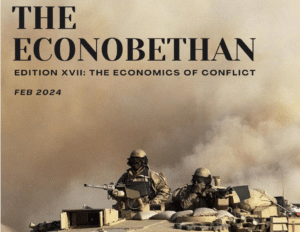 The first edition is contained within the pages of The Econobethan, the School’s well-established Economics and Politics magazine, but future editions are intended to be stand-alone publications.
The first edition is contained within the pages of The Econobethan, the School’s well-established Economics and Politics magazine, but future editions are intended to be stand-alone publications.
Edition XVII of The Econobethan takes as its theme The Economics of Conflict, looking at economic topics in theatres of war from Nazi Germany to the current conflicts in Ukraine and the Middle East.
Headmaster Neil Enright said: “My congratulations go to the team who have launched Bioquest – I hope it will be the first edition of many. It is also good to see such a high-quality edition of The Econobethan.
“Such publications provide excellent opportunities for boys to display genuine academic curiosity and scholarship. Through its thematic approach, The Econobethan demonstrates how the big issues cut across disciplines.
“It is important that our pupils develop an understanding of the world around them, and these publications show that they are taking great interest and thinking carefully about context.”
Bioquest is produced by a six-strong editorial team. One of them, Year 12’s Advik Balaji, appeals in his introduction for “dedicated scientists to contribute articles” for future editions.
Its six articles all feature colour illustrations and are all written by pupils in Year 12. They include Kavinayan Manivannan’s investigation of The Plants’ Trojan Horse, which explores plant cells’ use of RNA defence systems against necrotrophic fungi. Shivam Vyas looks at Microbiome Engineering in Plants, considering how a recent research breakthrough could “dramatically cut the use of pesticides and unlock opportunities to bolster plant health”.
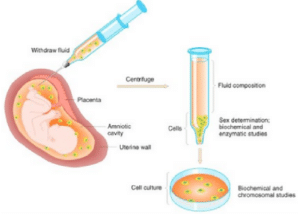 Seyed Jalili considers how the identification of CHIP (Clonal Hematopoiesis of Indeterminate Potential) in human blood cells might translate into effective treatments. Joshua John looks at the ethical implications of genetic screening in his piece entitled The Cost of a Human Life.
Seyed Jalili considers how the identification of CHIP (Clonal Hematopoiesis of Indeterminate Potential) in human blood cells might translate into effective treatments. Joshua John looks at the ethical implications of genetic screening in his piece entitled The Cost of a Human Life.
Within the Economics of Conflict-themed section of The Econobethan, the writers look both at particular wars and at economic lessons to be drawn from conflicts more generally. For example, Year 12’s Akheel Kale reflects on The Bizarre Nature of ‘Hitlernomics’ and Suryansh Sarangi, also of Year 12, explores the legacy of the British selling opium in China on the Chinese economy.
The magazine also includes a more general section on Economics, Politics and History.
- For those with access to the School’s eQE network, The Econobethan and Bioquest may be viewed here.

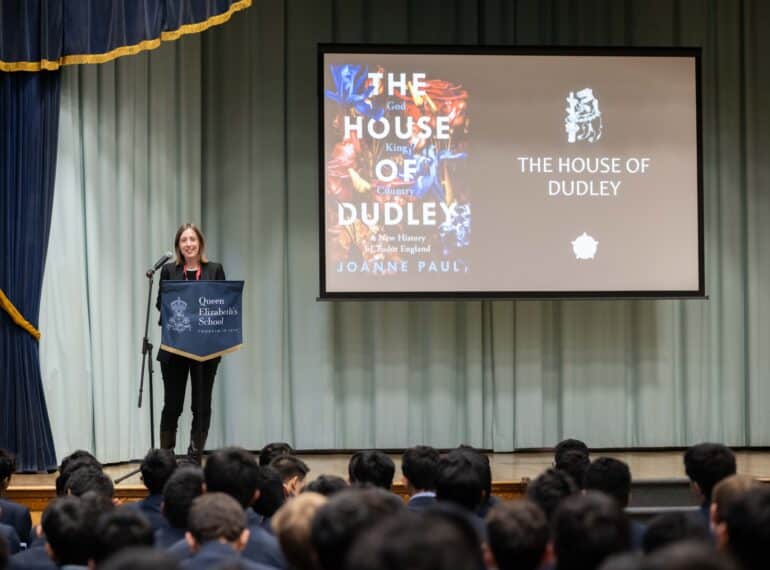
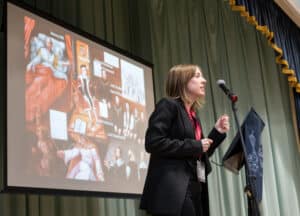 Dr Paul, author of the acclaimed 2022 book, The House of Dudley, delivered a lecture assembly to Years 8 & 9, before conducting a source-based workshop to A-level historians.
Dr Paul, author of the acclaimed 2022 book, The House of Dudley, delivered a lecture assembly to Years 8 & 9, before conducting a source-based workshop to A-level historians.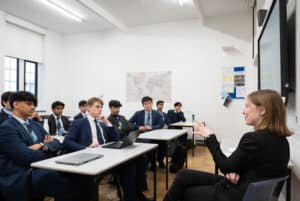 Headmaster Neil Enright said: “We are tremendously grateful to Dr Paul for giving us her time and providing these insights into the family as we wrap up our anniversary year. It seems clear that without the Dudleys, not only would Queen Elizabeth’s School not exist, but neither would the Tudors – or not as we know them, in any case.”
Headmaster Neil Enright said: “We are tremendously grateful to Dr Paul for giving us her time and providing these insights into the family as we wrap up our anniversary year. It seems clear that without the Dudleys, not only would Queen Elizabeth’s School not exist, but neither would the Tudors – or not as we know them, in any case.”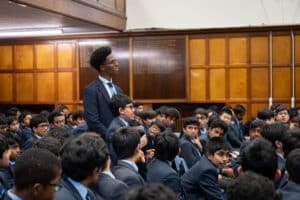 John Dudley’s success in building up the Royal Navy, as Admiral of the Fleet. He prepared it for the successes it was to enjoy in the second half of the 16th century. He added to the fleet and to the armoury, while developing Portsmouth as a great port. His military experience and leadership were important at the 1545 Battle of the Solent against the French, which, Dr Paul said, was a greater threat to England than the later Spanish Armada. John Dudley was nearly on the Mary Rose, which famously sank, but had moved across to the larger Great Harry with the king, Henry VIII.
John Dudley’s success in building up the Royal Navy, as Admiral of the Fleet. He prepared it for the successes it was to enjoy in the second half of the 16th century. He added to the fleet and to the armoury, while developing Portsmouth as a great port. His military experience and leadership were important at the 1545 Battle of the Solent against the French, which, Dr Paul said, was a greater threat to England than the later Spanish Armada. John Dudley was nearly on the Mary Rose, which famously sank, but had moved across to the larger Great Harry with the king, Henry VIII. The boys asked many questions. One wondered why so many grammar schools like QE were established under Elizabeth. Because, Dr Paul said, men such as Robert Dudley and William Cecil, her chief adviser, had received a humanist education and sought to spread that widely. Another asked why Henry VIII had had Edmund killed, given that he had brought so much money into royal coffers. She concluded that Henry probably had no personal animus against him, but that Edmund’s unpopularity made his death a good political move.
The boys asked many questions. One wondered why so many grammar schools like QE were established under Elizabeth. Because, Dr Paul said, men such as Robert Dudley and William Cecil, her chief adviser, had received a humanist education and sought to spread that widely. Another asked why Henry VIII had had Edmund killed, given that he had brought so much money into royal coffers. She concluded that Henry probably had no personal animus against him, but that Edmund’s unpopularity made his death a good political move.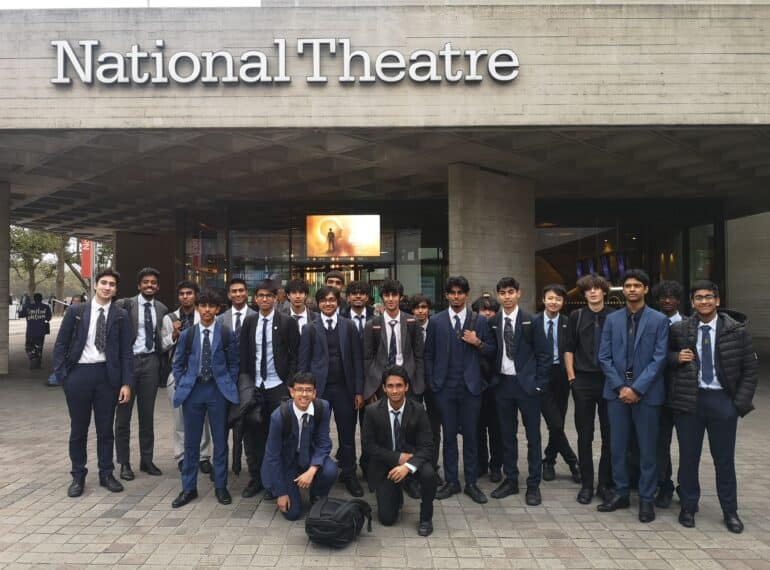
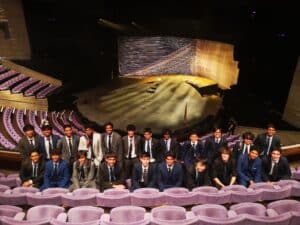 Twenty-two Year 12 boys and their teachers went on the History department trip to the National Theatre to see The Father and the Assassin.
Twenty-two Year 12 boys and their teachers went on the History department trip to the National Theatre to see The Father and the Assassin.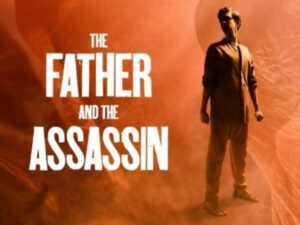 Regardless of their background, the visit enhanced all the boys’ understanding of Indian independence, showing how competing visions of a post-colonial India clashed, Mr Haswell added. They also appreciated the unique power of theatre to bring such ideas to life.
Regardless of their background, the visit enhanced all the boys’ understanding of Indian independence, showing how competing visions of a post-colonial India clashed, Mr Haswell added. They also appreciated the unique power of theatre to bring such ideas to life.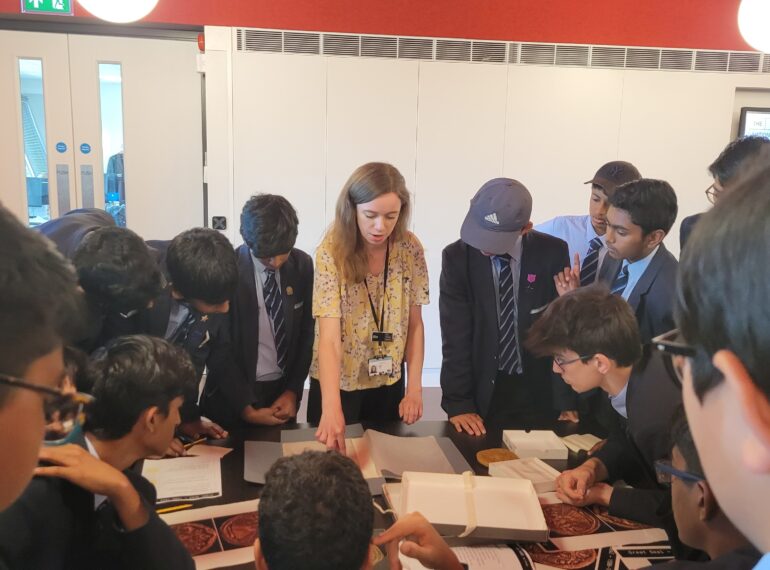
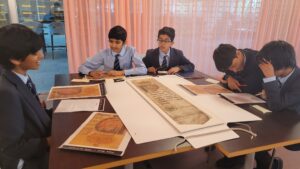 Among the artefacts viewed by the group during their visit to Kew was the actual letter – known as the ‘Tide Letter’ – written by the future Queen Elizabeth I, founder of Queen Elizabeth’s School, as she battled for survival following her arrest in 1554.
Among the artefacts viewed by the group during their visit to Kew was the actual letter – known as the ‘Tide Letter’ – written by the future Queen Elizabeth I, founder of Queen Elizabeth’s School, as she battled for survival following her arrest in 1554.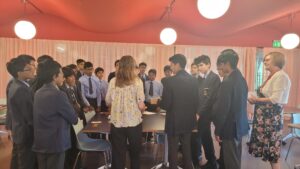 The visit was a reward for the boys who submitted the best entries to Project 1573. This involved small groups of boys being given three primary sources relating to a particular aspect of QE’s history and then asked to produce a three-minute presentation after accessing
The visit was a reward for the boys who submitted the best entries to Project 1573. This involved small groups of boys being given three primary sources relating to a particular aspect of QE’s history and then asked to produce a three-minute presentation after accessing 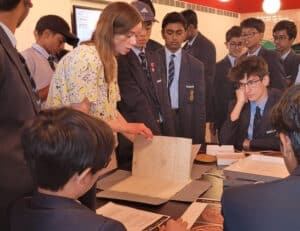 Kelvin Chen, Ethan Yao, Jonas Dawit and Rishi Sen, also of Year 8 Pearce, researching E W Harrison, a long-serving teacher who retired in 1950 and is one of the two unrelated people after whom the Harrisons’ House is named
Kelvin Chen, Ethan Yao, Jonas Dawit and Rishi Sen, also of Year 8 Pearce, researching E W Harrison, a long-serving teacher who retired in 1950 and is one of the two unrelated people after whom the Harrisons’ House is named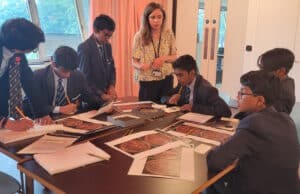 “The students were able to see the neat handwriting at the start of the letter become larger and messier as she was likely made to hurry by those waiting to escort her to the Tower. Fearing her enemies might alter the letter, Elizabeth struck lines through the blank space above her signature,” said Mrs Blackford.
“The students were able to see the neat handwriting at the start of the letter become larger and messier as she was likely made to hurry by those waiting to escort her to the Tower. Fearing her enemies might alter the letter, Elizabeth struck lines through the blank space above her signature,” said Mrs Blackford.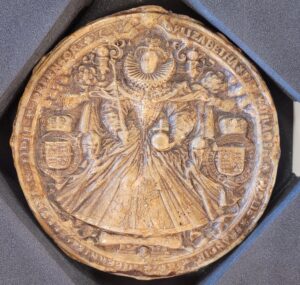 QE’s founding Royal Charter of 1573 was authorised with Queen Elizabeth’s first seal. This, however, wore out during her long reign, and, Ms Blackford said, the boys enjoyed finding out about its replacement: “It is noticeably more elaborate, as Elizabeth had started to closely monitor her image.”
QE’s founding Royal Charter of 1573 was authorised with Queen Elizabeth’s first seal. This, however, wore out during her long reign, and, Ms Blackford said, the boys enjoyed finding out about its replacement: “It is noticeably more elaborate, as Elizabeth had started to closely monitor her image.”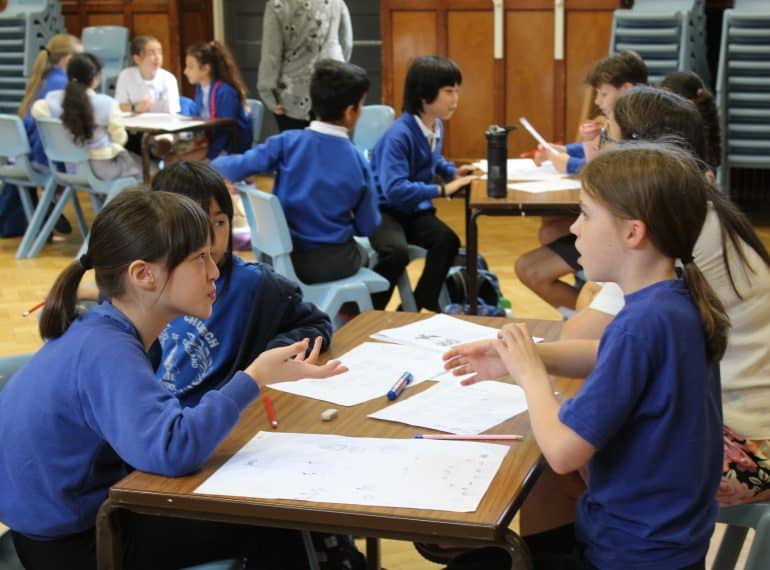
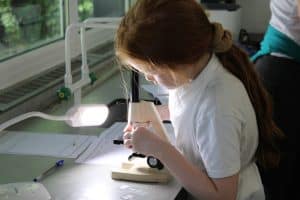 The events, which are part of QE’s partnerships work with the local community, are aimed at giving Year 5 girls and boys an early taste of secondary school education.
The events, which are part of QE’s partnerships work with the local community, are aimed at giving Year 5 girls and boys an early taste of secondary school education.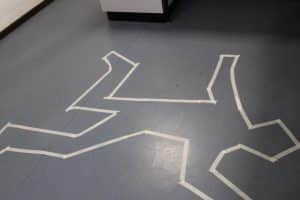 The first of the three days was the ever-popular Primary Forensics Workshop. The visitors were tasked with completing a number of experiments and analyses to work out who had murdered the Headmaster!
The first of the three days was the ever-popular Primary Forensics Workshop. The visitors were tasked with completing a number of experiments and analyses to work out who had murdered the Headmaster!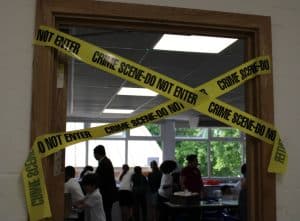 Boys from Year 12 helped staff run this workshop, engaging with the children at each station.
Boys from Year 12 helped staff run this workshop, engaging with the children at each station.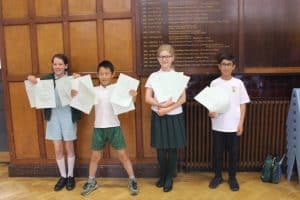 Firstly, teams were given the challenge of designing a castle on paper. They had to base their design on a certain set of criteria and follow a budget, requiring them to decide which features they wanted to prioritise.
Firstly, teams were given the challenge of designing a castle on paper. They had to base their design on a certain set of criteria and follow a budget, requiring them to decide which features they wanted to prioritise.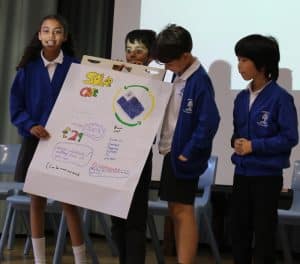 There was then a Sustainability Challenge run jointly by Geography and Economics. The children had to work in groups and devise a sustainable product. They designed their product, chose a logo and decided on their target market. Then each group presented to the other children in attendance. Among the ideas generated were: a mobile phone where the case is a solar panel and charges the phone, and a ‘plastic’ bottle where the bottle itself is biodegradable.
There was then a Sustainability Challenge run jointly by Geography and Economics. The children had to work in groups and devise a sustainable product. They designed their product, chose a logo and decided on their target market. Then each group presented to the other children in attendance. Among the ideas generated were: a mobile phone where the case is a solar panel and charges the phone, and a ‘plastic’ bottle where the bottle itself is biodegradable.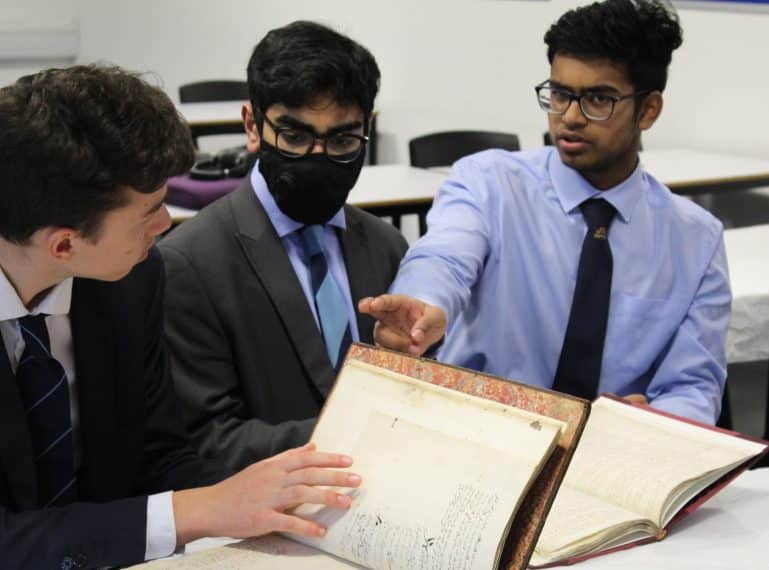
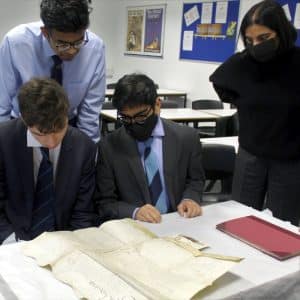 English teacher Kanak Shah has brought together a group of dedicated Year 12 boys and trained them in palaeography – the study of ancient and pre-modern manuscripts.
English teacher Kanak Shah has brought together a group of dedicated Year 12 boys and trained them in palaeography – the study of ancient and pre-modern manuscripts.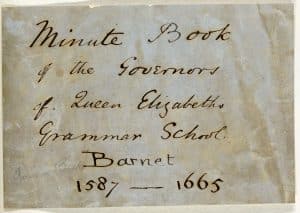 “The earliest documents present an interesting challenge as they were written before the standardisation of handwriting, and so require careful decoding,” said Ms Shah.
“The earliest documents present an interesting challenge as they were written before the standardisation of handwriting, and so require careful decoding,” said Ms Shah.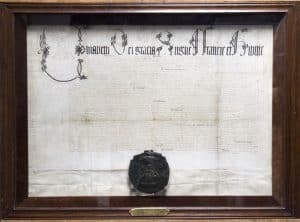 It is not clear who made the the Barnet Museum transcription, which was completed some time prior to 1931. The preface to the museum’s collection of QE translations and transcriptions was written in May 1931 by Cecil L Tripp, author of A History of Queen Elizabeth’s Grammar School, published 1935.
It is not clear who made the the Barnet Museum transcription, which was completed some time prior to 1931. The preface to the museum’s collection of QE translations and transcriptions was written in May 1931 by Cecil L Tripp, author of A History of Queen Elizabeth’s Grammar School, published 1935.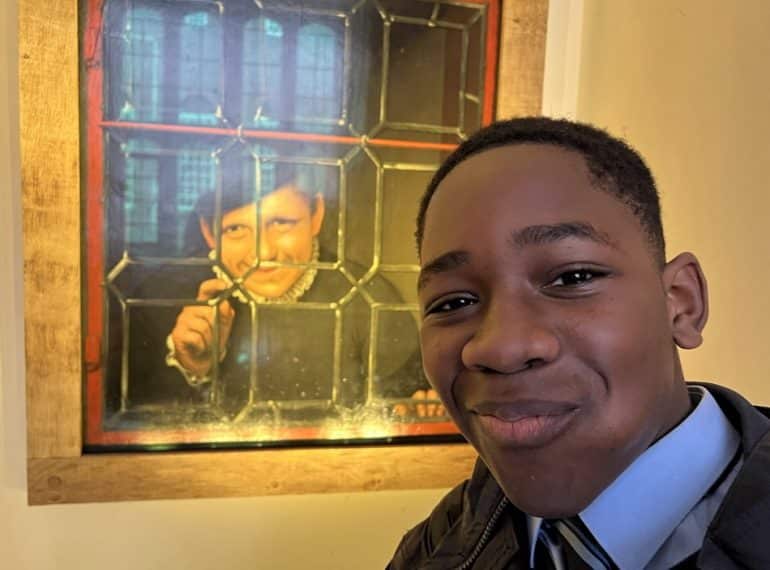
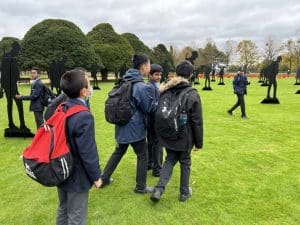 At the palace, the boys learned about Tudor life and saw at first-hand evidence of the School’s own links with the Tudor monarchy. They also had the opportunity to see a special exhibition and art installation – on for this month only – featuring silhouetted figures of Sikh soldiers from the British Empire’s Indian Army.
At the palace, the boys learned about Tudor life and saw at first-hand evidence of the School’s own links with the Tudor monarchy. They also had the opportunity to see a special exhibition and art installation – on for this month only – featuring silhouetted figures of Sikh soldiers from the British Empire’s Indian Army.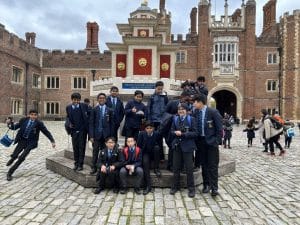 “Our pupils were fascinated, too, by the carved wooden ceilings in the Great Hall, picturing to themselves Henry VIII sitting under them and also, a few decades later, performances there by Shakespeare’s own theatre company.
“Our pupils were fascinated, too, by the carved wooden ceilings in the Great Hall, picturing to themselves Henry VIII sitting under them and also, a few decades later, performances there by Shakespeare’s own theatre company.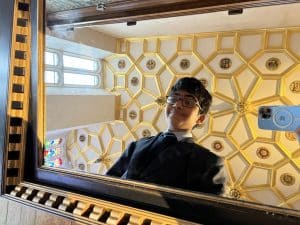 Braving the chilly weather, the QE groups enjoyed a walk around the park and formal gardens, during which they spied a herd of deer across a water feature to the rear of the palace.
Braving the chilly weather, the QE groups enjoyed a walk around the park and formal gardens, during which they spied a herd of deer across a water feature to the rear of the palace.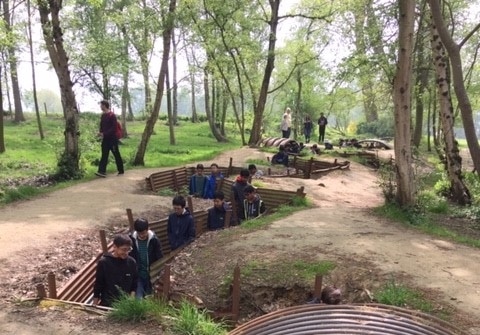
 Head of History Helen MacGregor said the extra visit proved popular with the boys, for whom the whole trip was organised to fit in with Year 9’s History theme about the changing nature of warfare and to explore the links between World War I and World War II.
Head of History Helen MacGregor said the extra visit proved popular with the boys, for whom the whole trip was organised to fit in with Year 9’s History theme about the changing nature of warfare and to explore the links between World War I and World War II.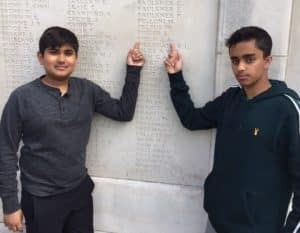 This was followed by a tour of Tyne Cot Commonwealth War Graves Cemetery, where the boys searched out the names of Old Elizabethans who fought and died in the First World War. They included Jack Field, who had been the School Captain and was just 19 when he was killed. In the evening, the pupils watched the daily Menin Gate remembrance ceremony, which was first performed in 1928. Every evening, the busy road through the memorial arch is closed and The Last Post is played.
This was followed by a tour of Tyne Cot Commonwealth War Graves Cemetery, where the boys searched out the names of Old Elizabethans who fought and died in the First World War. They included Jack Field, who had been the School Captain and was just 19 when he was killed. In the evening, the pupils watched the daily Menin Gate remembrance ceremony, which was first performed in 1928. Every evening, the busy road through the memorial arch is closed and The Last Post is played. Miss MacGregor said: “The boys were clearly moved by the ceremony and took the time to remember the war dead, including the Sikh regiment who are commemorated there.”
Miss MacGregor said: “The boys were clearly moved by the ceremony and took the time to remember the war dead, including the Sikh regiment who are commemorated there.”

 The party of 30 boys from Years 12 and 13, along with four members of staff, landed in Moscow for a six-day, two-city tour, during which they learned more about Russian life, from the era of the Tsars through the soviet period and up to the present day.
The party of 30 boys from Years 12 and 13, along with four members of staff, landed in Moscow for a six-day, two-city tour, during which they learned more about Russian life, from the era of the Tsars through the soviet period and up to the present day. In the evening there was a total change of mood with a visit to the HC Spartak Ice Hockey stadium. The group stayed in a hotel for the first night where they partook of traditional Russian fare, namely borscht and cabbage soup. “The boys enjoyed trying the local food, but Moscow’s McDonalds was also a hit,” added Miss MacGregor.
In the evening there was a total change of mood with a visit to the HC Spartak Ice Hockey stadium. The group stayed in a hotel for the first night where they partook of traditional Russian fare, namely borscht and cabbage soup. “The boys enjoyed trying the local food, but Moscow’s McDonalds was also a hit,” added Miss MacGregor. “The boys were blown away by the beauty of the palaces there. So much gold and decoration, including the Amber Room in the Catherine Palace, which had to be recreated after it was dismantled and disappeared during WWII, presumably looted by the Nazis.”
“The boys were blown away by the beauty of the palaces there. So much gold and decoration, including the Amber Room in the Catherine Palace, which had to be recreated after it was dismantled and disappeared during WWII, presumably looted by the Nazis.”